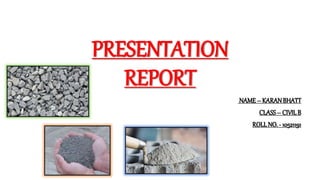
Coarse Aggregate and Cement Manufacturing Processes
- 1. PRESENTATION REPORT NAME– KARANBHATT CLASS– CIVILB ROLL NO. - 10521191
- 2. COARSE AGGREGATE Coarse aggregates refer to irregular and granular materials such as sand, gravel, or crushed stone, and are used for making concrete. In most cases, Coarse is naturally occurring and can be obtained by blasting quarries or crushing them by hand or crushers. It is imperative to wash them before using them for producing concrete. Their angularity and strength affect the concrete in numerous ways. Needless to say, the selection of these aggregates is a very important process. Materials that are large enough to be retained on the 4.7mm sieve size usually constitute coarse aggregates and can reach a maximum size of 63mm.
- 3. MANUFACTURING PROCESS Gravels constitute the majority of coarse aggregate used in concrete with crushed stone making up most of the remainder. Natural gravel and sand are usually dug or dredged from a pit, river, lake, or seabed. Crushed aggregate is produced by crushing quarry rock, boulders, cobbles, or large-size gravel. Recycled concrete is a viable source of aggregate and has been satisfactorily used in granular subbases, soil- cement, and in new concrete. After harvesting, aggregate is processed: crushed, screened, and washed to obtain proper cleanliness and gradation. If necessary, a benefaction process such as jigging or heavy media separation can be used to upgrade the quality. Once processeds, the aggregates are handled and stored to minimize segregation and degradation and prevent contamination.
- 6. CEMENT Cement, one of the most important building materials, is a binding agent that sets and hardens to adhere to building units such as stones, bricks, tiles, etc. Cement generally refers to a very fine powdery substance chiefly made up of limestone (calcium), sand or clay (silicon), bauxite (aluminum) and iron ore, and may include shells, chalk, marl, shale, clay, blast furnace slag, slate. The raw ingredients are processed in cement manufacturing plants and heated to form a rock-hard substance, which is then ground into a fine powder to be sold. Cement mixed with water causes a chemical reaction and forms a paste that sets and hardens to bind individual structures of building materials. Cement is an integral part of the urban infrastructure. It is used to make concrete as well as mortar, and to secure the infrastructure by binding the building blocks. Concrete is made of cement, water, sand, and gravel mixed in definite proportions, whereas mortar consists of cement, water, and lime aggregate. These are both used to bind rocks, stones, bricks, and other building units, fill or seal any gaps, and to make decorative patterns. Cement mixed with water silicates and aluminates, making a water repellant hardened mass that is used for water-proofing.
- 7. MANUFACTURING PROCESS Cement is manufactured through a closely controlled chemical combination of calcium, silicon, aluminum, iron and other ingredients. Common materials used to manufacture cement include limestone, shells, and chalk or marl combined with shale, clay, slate, blast furnace slag, silica sand, and iron ore. These ingredients, when heated at high temperatures form a rock-like substance that is ground into the fine powder that we commonly think of as cement. Cement plant laboratories check each step in the manufacture of Portland cement by frequent chemical and physical tests. The labs also analyze and test the finished product to ensure that it complies with all industry specifications. The most common way to manufacture Portland cement is through a dry method. The first step is to quarry the principal raw materials, mainly limestone, clay, and other materials. After quarrying the rock is crushed. This involves several stages. The first crushing reduces the rock to a maximum size of about 6 inches. The rock then goes to secondary crushers or hammer mills for reduction to about 3 inches or smaller. The crushed rock is combined with other ingredients such as iron ore or fly ash and ground, mixed, and fed to a cement kiln.
- 8. The cement kiln heats all the ingredients to about 2,700 degrees Fahrenheit in huge cylindrical steel rotary kilns lined with special firebrick. Kilns are frequently as much as 12 feet in diameter—large enough to accommodate an automobile and longer in many instances than the height of a 40-story building. The large kilns are mounted with the axis inclined slightly from the horizontal. The finely ground raw material or the slurry is fed into the higher end. At the lower end is a roaring blast of flame, produced by precisely controlled burning of powdered coal, oil, alternative fuels, or gas under forced draft. As the material moves through the kiln, certain elements are driven off in the form of gases. The remaining elements unite to form a new substance called clinker. Clinker comes out of the kiln as grey balls, about the size of marbles. Clinker is discharged red-hot from the lower end of the kiln and generally is brought down to handling temperature in various types of coolers. The heated air from the coolers is returned to the kilns, a process that saves fuel and increases burning efficiency. After the clinker is cooled, cement plants grind it and mix it with small amounts of gypsum and limestone. Cement is so fine that 1 pound of cement contains 150 billion grains. The cement is now ready for transport to ready-mix concrete companies to be used in a variety of construction projects. Although the dry process is the most modern and popular way to manufacture cement, some kilns in the United States use a wet process. The two processes are essentially alike except in the wet process, the raw materials are ground with water before being fed into the kiln.
- 10. THANK YOU